Ahsan A. (ed.) Evaporation, Condensation and Heat transfer
Подождите немного. Документ загружается.


Fluid Flow and Heat Transfer Analyses in Curvilinear Microchannels
409
Also in this work, C
f
. Re and Nusselt number are obtained using the following equations.
2
2
4( ( ))
()
Re
((,))
tang
w
f
yx
ux
C
n
uxydy
∂
=
∂
∫
(31)
1()
() 1
ave
w
x
Nu
xn
θ
θ
∂
=
−∂
(32)
where y
w
(x) represents the half width of microchannel and
θ
ave
is the nondimensional
average temperature of fluid.
6. Numerical solution
In the present work, the slip flow regime with the Knudsen number ranging from 0.01 to 0.1
is considered. The study is limited to incompressible flow. Flow with Mach number lower
than 0.3 can be assumed incompressible. The following equation is used to check this limit
[22].
Re
2
Ma
Kn
π
γ
= (33)
SIMPLE algorithm in non-orthogonal curvilinear coordinate framework is used to solve the
governing equations with appropriate boundary conditions [24]. A fully implicit scheme is
used for the temporal terms and the HYBRID differencing [25] is applied for the
approximation of the convective terms. A full-staggered grid is applied in which scalar
variables such as pressure and temperature at ordinary points are evaluated but velocity
components are calculated around the cell faces. Also the control volumes for u and v are
different from the scalar control volumes and different from each other. The Poisson
equations is solved for (x, y) to find grid points [19] and are distributed in a nonuniform
manner with higher concentration of grids close to the curvy walls and normal to all walls,
as shown in Fig. 1. In this work, two convergence criteria have been imposed. First
convergence criterion is a mass flux residual less than 10-8 for each control volume. Another
criteria that is established for the steady state flow is (|φ
i+1
- φ
i
|)/|φ
i+1
| ≤10
-10
where φ
represents any dependent variable, namely u, v and θ, and i is the number of iteration.
The numerical code and non-orthogonal grid discretization scheme used in the present
study have been validated in Fig. 3.a. against the previously published results of Wang and
Chen [11]. Their model is similar to the present model, but water was used as a working
fluid and the channel scale was macro. The slip effects approximately exterminated with
fixing Kn number at zero.
To investigate the accuracy of the used numerical model for the special case of
microchannel, the obtained numerical results for slip flow are compared with analytical
results of microchannel in [26]. The used parameters in [26] for nondimensional temperature
and Nusselt number can be shown in terms of this work as follows:
22 2 2
1 6 Pr(1 )[3(1 ) {( )[1 3( )] 2 }]
ss
iT
mm
uu
Ec
yy yy yy
Kn
uu
θβ
=+ − − + − − − + (34)

Evaporation, Condensation and Heat Transfer
410
21
420 [27 (9 420 ) ( ) ]
sss
t
mmm
uuu
Nu Kn
uuu
β
−
∞
=++ − (35)
Which
2
v
v
v
σ
β
σ
−
=
,
221
1Pr
T
T
T
σγ
β
σγ
−
=
+
(23)
Fig. 3a. Validation of the numerical code with available data
This comparison is carried out for the Kn=0.04, Pr=0.7, Pe=0.5, Ec=0.286, β
v
=1 and β
T
=1.667.
In the numerical code, two dimensional forms are considered for the convective and
diffusive terms. To compare the analytical and numerical solutions, the viscous dissipation
term in the analytical solution is also added to the numerical solution. Also the flow work
term in the analytical solution is considered in the numerical model. The analytical solution
results 3.47 for the Nusselt number, while the numerical model gives 3.53 for the fully
developed Nusselt number which are in a good agreement. Furthermore, the
nondimensional temperature profiles for the two models are shown in Fig. 3.b. which are
also in a good agreement.
To ensure that the results of the numerical study are independent of the computational grid;
a grid sensitivity analysis is performed for steady state. In this work, three meshes are used
in numerical simulation: 350×65, 400×75 and 450×85. Generally, the accuracy of the solution
and the time required for the solution are dependent on mesh refinement. In this work, the
optimum grid is searched to have appropriate run-time and enough accuracy. As it is shown
in Fig. 4, the obtained solution with mentioned grids shows sufficient accuracy. For
Kn=0.075 at Re=2, 400×75 grid seems to be optimum in accuracy and run-time. Grid
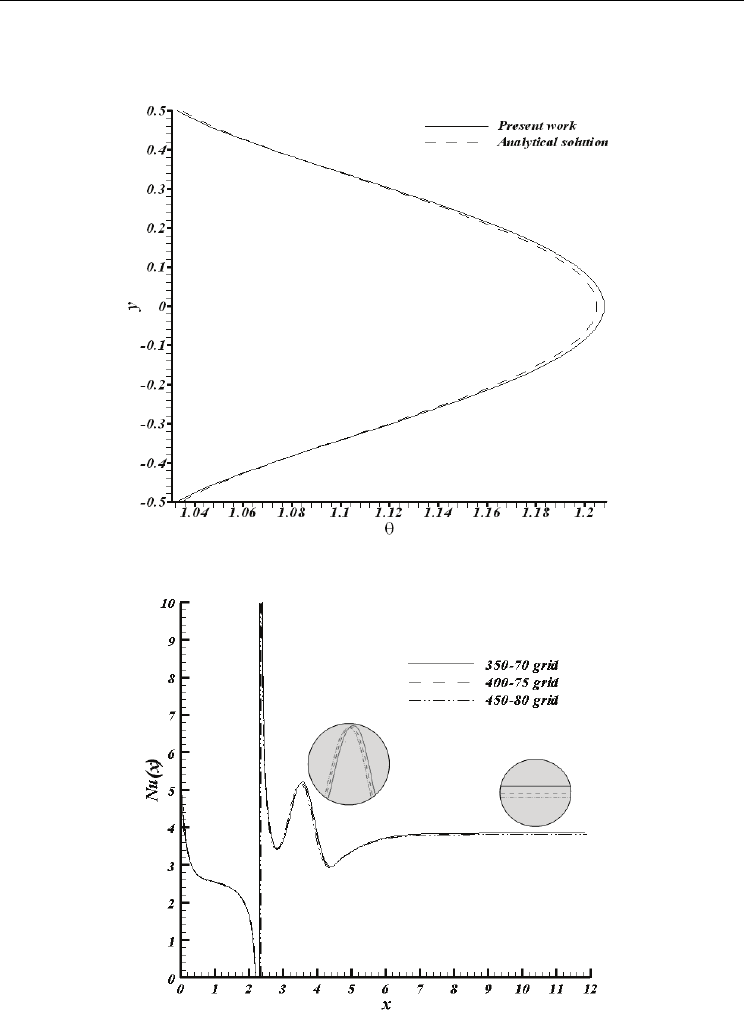
Fluid Flow and Heat Transfer Analyses in Curvilinear Microchannels
411
dependence studies have been completed with similar results for each numerical solution
presented in the results section. However, throughout this study the results are only
presented for the optimum grid.
Fig. 3b. Validation of the numerical code with available data
Fig. 4. Numerical results of local Nusselt number along the constricted microchannel with
KN=0.075 at Re=2 and a=0.15

Evaporation, Condensation and Heat Transfer
412
7. Results and discussion
To have a clear understanding of the problem and studding the fluid flow and heat transfer
characteristics (e.g. the velocity field, local temperature field, friction factor and local
Nusselt number), numerical simulation is performed for different values of Knudsen
numbers and various amplitude values. Because of the symmetrical geometry, in this work,
only one half of microchannel shown in Fig. 1 is numerically solved. Therefore, the run-time
reduces considerably. However, the results depicted for the whole microchannel. The results
are obtained for
γ=1.4, Pr=0.7, σ
T
=0.9 and σ
v
=0.9. Also surface wavelength is taken λ=2. The
boundaries are maintained at temperature T
w
=70
o
C and the uniform inlet temperature is
considered T
i
=25
o
C. Furthermore, the five studied Knudsen numbers and corresponding
Eckert number is shown in Table 1.
Kn=0.01 Kn=0.025 Kn=0.05 Kn=0.075 Kn=0.1
Ec
-4
4.82 10×
-3
3.01 10×
-2
1.21 10×
-2
2.71 10×
-2
4.82 10×
Table 1. Numerical values for Ec as a function of Kn at Re=2
7.1 The flow field
The effect of Kn on slip velocity for hydrodynamically/thermally developing flow in the
constricted microchannel is depicted in Fig. 5. As observed the slip velocity experiences a
rapid jump in the convergent region at each Knudsen number. In the convergent region, the
cross section area decreases and causes the acceleration of the fluid flow. So the average
velocity increases and this increase contributes to a rapid raise in the slip velocity in this
region. In addition, as the rarefaction effect increases, the slip velocity increases. By increasing
the Knudsen number, the channel dimensions decrease and approach to molecular
dimensions. Physically, decreasing channel dimensions causes a decline in the interaction of
gaseous molecules with the adjacent walls. So the momentum exchange between the fluid and
adjacent walls declines. In other words, the fluid molecules are lesser affected by the walls that
leads to larger slip velocity. The increase in slip velocity can be explained in other words. As
the microchannel dimensions decrease, the MFP (mean free path) becomes more comparable
with the microchannel’s characteristic length in size. This means that the thickness of Knudsen
layer increases that causes an increase in the slip velocity.
A schematic comparison between the velocity profile in different Knudsen numbers and in
different cross sections is carried out in Fig. 6. As expected, as the fluid approaches the
throttle region, the slip velocity gets higher value. As expected also, by intensification of
rarefaction effect, the slip velocity increases.
Fig. 7 displays C
f
.Re versus Knudsen number for hydrodynamically/thermally developing
flow in the constricted microchannel. As shown, due to presence of high velocity gradients,
there is high friction in the entrance of channel. As expected, as flow develops, this high
friction rapidly declines. Furthermore, when fluid flows in the convergent region, C
f
.Re
experiences a rapid decrease in the microchannel. By referring to the definition of C
f
.Re in Eq.
(31), it can be noticed that there are three parameters affecting the behavior of C
f
.Re. The first
parameter is the square of channel width that decreases through the convergent region. The
second parameter is the inverse of square of the average velocity that decreases in the
convergent region. And finally the third parameter is the gradient of tangential velocity,
∂u
tang
(x)/∂n that increases in this region because of increase of the average velocity through
this area. Here, it seems that the effects of the first and second parameter are dominant and
make the C
f
.Re reduce in the convergent part. Furthermore, rarefaction has a decreasing effect

Fluid Flow and Heat Transfer Analyses in Curvilinear Microchannels
413
on the friction factor. As rarefaction increases, the slip velocity increases which results in a
flatter velocity profile and consequently reduces the wall velocity gradient. This reduction
contributes to the decrease of C
f
.Re with Knudsen number. For instance, by variation of
Knudsen number from 0.01 to 0.1, the C
f
.Re at the end of microchannel decreases 38%.
Moreover, physically by increasing the Knudsen number, the interaction of gaseous molecules
with the adjacent walls decreases. Therefore, the momentum exchange between the fluid and
adjacent walls reduces and this means C
f
.Re declines.
Fig. 5. Variation of slip velocity along the constricted microchannel with Knudsen number
Re=2 and a=0.15
Fig. 6. Schematic illustration of Knudsen number effect on velocity profile at Re=2 and
a=0.15
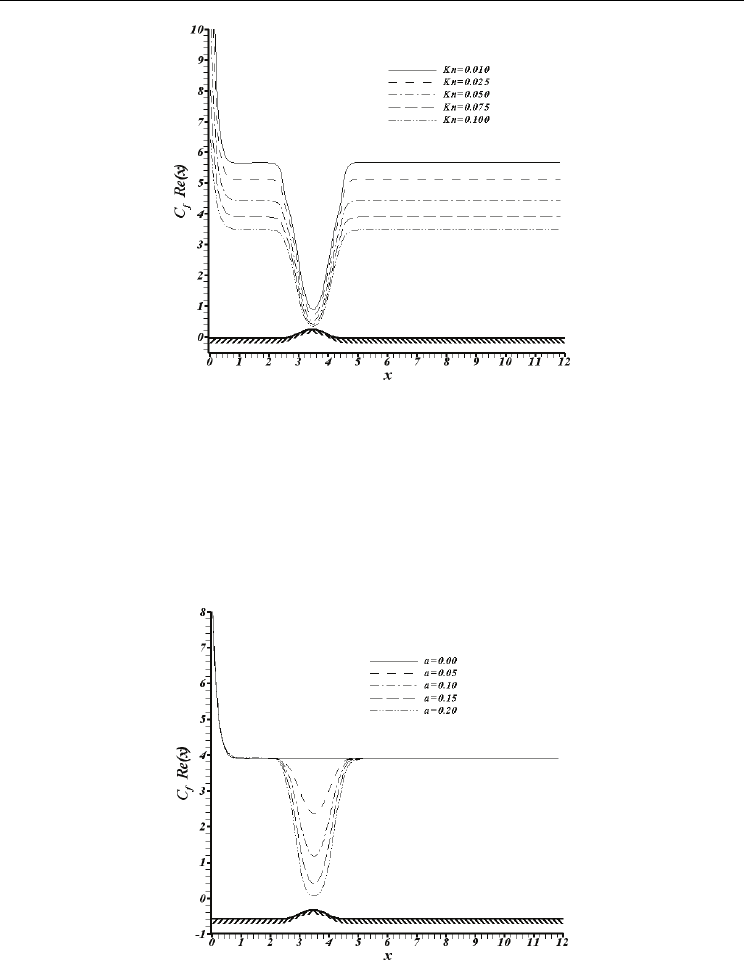
Evaporation, Condensation and Heat Transfer
414
Fig. 7. Variation of C
f
.Re along the constricted microchannel with Knudsen number at Re=2
and a=0.15
In Fig. 8 the variation of C
f
.Re as a function of the amplitude of wave is shown, while
keeping the Reynolds number and Knudsen number constant. As shown, by decreasing the
amplitude of the wave (i.e., increasing the constriction), the fluid flow senses the variation of
cross section more. In other words, by decreasing the amplitude of the wave and
consequently the more increase in the average velocity, C
f
.Re experiences more intense
decrease in the convergent region. For instance, by variation of amplitude of the wave from
0.05 to 0.15, the C
f
.Re decreases 82% in the throttle region.
Fig. 8. Variation of C
f
.Re along the constricted microchannel with amplitude of the wave at
Re=2 and Kn=0.075
A comparison is carried out in Fig. 9 to investigate the effect of viscous dissipation on C
f
.Re.
As shown, viscous dissipation inconsiderably affects C
f
.Re.
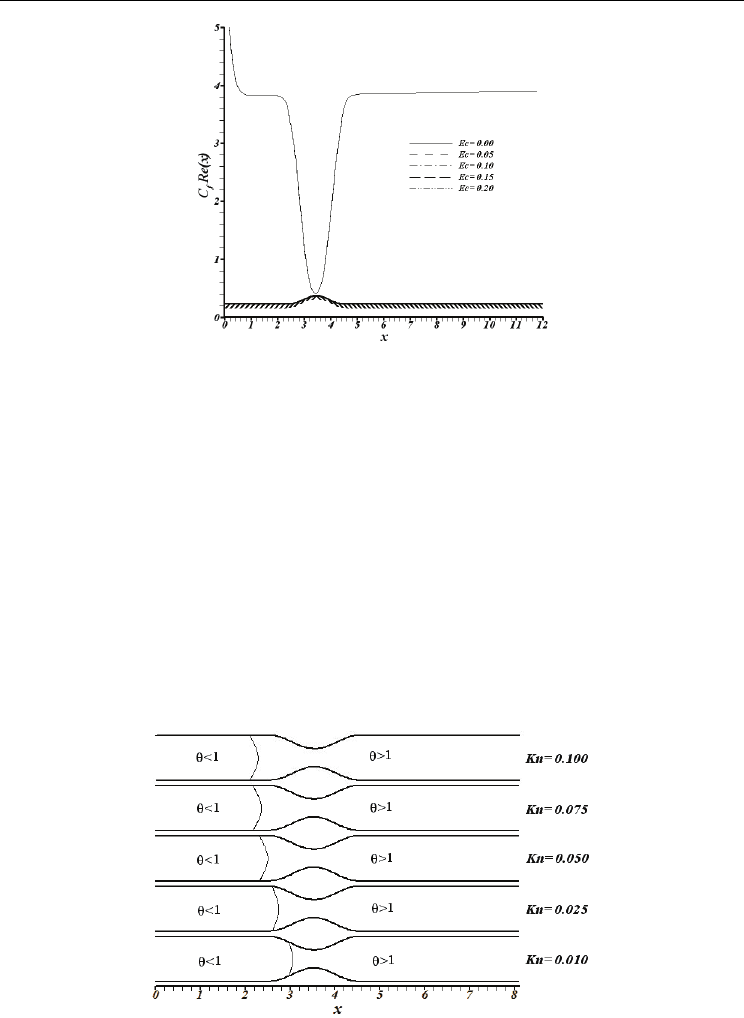
Fluid Flow and Heat Transfer Analyses in Curvilinear Microchannels
415
Fig. 9. Variation of local C
f
.Re with Eckert number at Re=2, Kn=0.075 and a=0.15
7.2 The temperature field
To clearly understand the physic of fluid flow, the isothermal lines corresponds to the non-
dimensional temperature of unity for five studies Knudsen number are illustrated in Fig. 10.
As observed, these isothermal lines clearly divide the physical domain in to two different
regions, the region of θ<1 in the inlet of channel and the region of θ>1 in the outlet of
channel. In the region of θ<1, where the non-dimensional temperature is less than unity, the
fluid receives energy from the adjacent walls, as the fluid flows through the channel. This
energy transfer from the walls to the fluid continues till the fluid approaches the region
close to θ=1 where the heat supplied by the walls is balanced by the internal heat generation
due to viscous heating. After this region, the internal heat generated by viscous dissipation
gets to such a high value that completely reverse the direction of heat transfer. In other
words, in the region of θ>1, the net energy exchange is from the fluid towards the walls.
With the above descriptions, it can be found that viscous dissipation plays an important role
in this kind of flows. Furthermore, the effect of viscous dissipation on fluid flow is more
considerable in higher Knudsen number as the region of θ>1expands.
Fig. 10. Isothermal line corresponds to non-dimensional temperature unity along the
constricted microchannel with Knudsen number at Re=2 and a=0.15
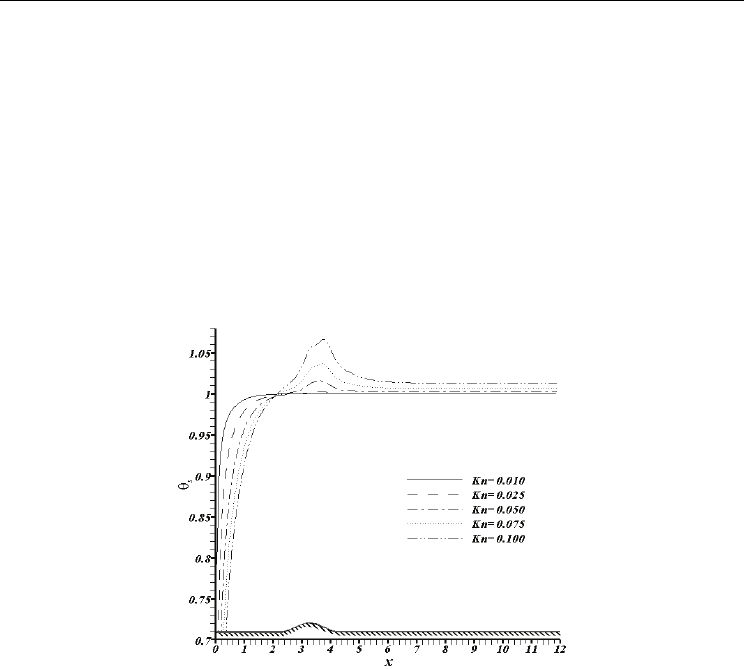
Evaporation, Condensation and Heat Transfer
416
Fig. 11 shows the effect of Knudsen number on temperature jump. By increasing the
Knudsen number and consequently the decreasing of channel dimensions, the thickness of
Knudsen layer increases. This increase leads to greater temperature jumps. However it
should be noted that this increase in temperature jump shows itself in two different ways. In
the inlet of microchannel, the fluid temperature near the wall is less than wall temperature
and this increase can be seen by lesser fluid temperature near the wall. While in the outlet of
channel, as the fluid temperature is higher than wall temperature, this increase can be
noticed by higher fluid temperature near the wall. For instance, in the outlet of channel for
Kn=0.1, the nondimensional fluid temperature near the wall is more than 1.01. Furthermore,
it can be noticed that the fluid temperature near the wall generally increases along the
microchannel. However, due to the convergent region, the fluid temperature at each
Knudsen number experiences a jump in this region. Moreover, in the developed region, the
fluid temperature near the wall approaches to a constant value.
Fig. 11. Variation of the fluid temperature near the wall with Knudsen number along the
constricted microchannel at Re=2 and a=0.15
The variation of average temperature along the microchannel versus Knudsen number is
illustrated in Fig. 12. As shown, in the entrance region of microchannel, the Knudsen number
has a decreasing effect on the average temperature. In this region, as the Knudsen number
increases, the fluid enters with greater inlet velocity and momentum and consequently
exchange less energy with the adjacent walls. Therefore, the average temperature decreases.
To study the effect of Knudsen number in the outlet region, one should consider the effect of
viscous dissipation due to importance of this effect is in this region. By increasing the
rarefaction effect, the velocity gradients become more considerable and consequently the effect
of viscous dissipation increases. Viscous dissipation acts like a thermal source that tends to
increase the average fluid temperature. In addition, due to the convergent region, the average
fluid temperature at each Knudsen number experiences a jump in this region.
In Fig. 13 and Fig. 14, temperature distribution in two different cross sections at x= 0.75
λ,
2.5
λ are presented. The temperature distribution in Fig. 13 is located in the region
corresponds to θ<1(the inlet region with lower viscous dissipation effects). In this region, as
expected with larger Knudsen number, we have higher temperature jump at the wall and
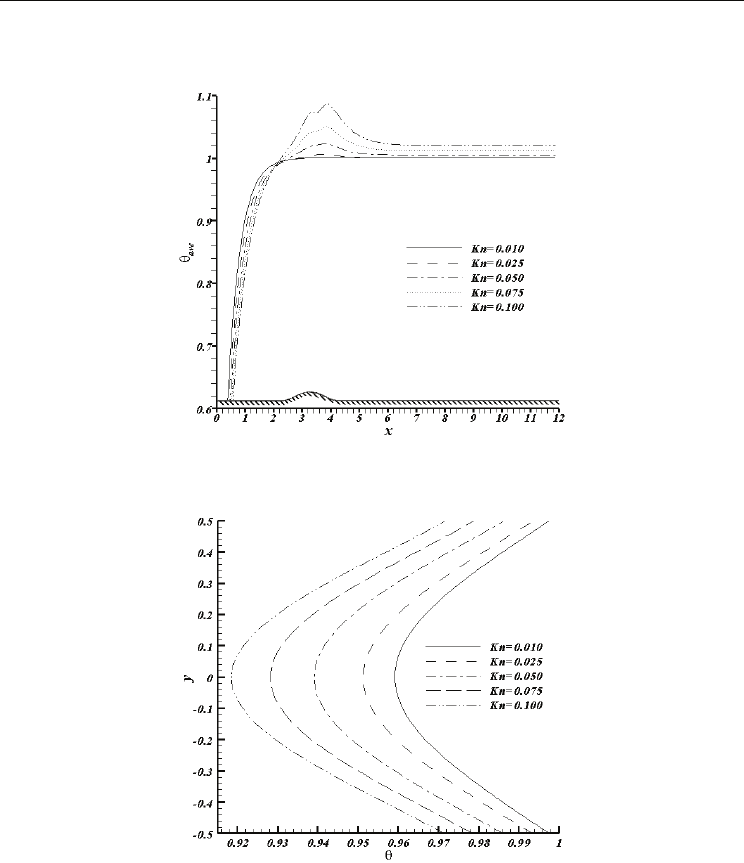
Fluid Flow and Heat Transfer Analyses in Curvilinear Microchannels
417
consequently a shift in the temperature distribution towards the inlet temperature.
Moreover, the tangential temperature gradients in this region are negative at lower wall.
Fig. 12. Variation of average temperature with Knudsen number along the constricted
microchannel at Re=2 and a=0.15
Fig. 13. Variation of temperature profile at x=0.75
λ in the constricted microchannel with
Knudsen number at Re=2 and a=0.15
In Fig. 14, the temperature profiles are located in the region of θ>1 (the outlet region with
higher viscous dissipation effects). As mentioned above, in this region the increasing effect
of Knudsen number on temperature jump is in different direction. As Knudsen number
increases, the temperature distribution shifts towards higher temperatures. In addition, in
this region tangential temperature gradients at lower wall are positive and also are larger
with higher Knudsen numbers.

Evaporation, Condensation and Heat Transfer
418
Fig. 14. Variation of temperature profile at x=2.5
λ in the constricted microchannel with
Knudsen number at Re=2 and a=0.15
The effect of Knudsen number on local Nusselt number is depicted in Fig. 15. As observed,
due to high temperature gradients in the entrance of microchannel, local Nusselt number
has great value in this region. However this high heat transfer rates diminish rapidly as the
flow develops thermally. After the entrance region and before the constricted part, a
singular point is observed at each Knudsen number where the value of Nusselt number goes
to infinity. However, the Nusselt number goes to infinity, it does not mean that there is
infinite heat transfer in this point at all. The physical reason is that at this point the average
temperature and wall temperature have locally the same value and their difference
vanishes. In other word, at this point the heat supplied by the walls equals the heat
generated by viscous dissipation effect and there is no net heat transfer at this point between
the wall and the adjacent fluid. By increasing the Knudsen number and consequently
increasing the viscous dissipation effect, this singular point occurs at closer distances to the
entrance of channel. This effect also was observed in Fig. 10 where by increasing Knudsen
number, the region of θ>1 grows. Furthermore, the Nusselt number is positive before and
after the singular point. According to Eq. (32), two different parameters determine the sign
of Nusselt number, the tangential temperature gradient and the difference of average
nondimensional temperature and wall temperature. In the region of θ<1 (i.e. the region
before the singular point) the difference of average nondimensional temperature and wall
temperature is negative and according to Fig. 13, the tangential temperature gradient is also
negative. So Nusselt number is positive. On the contrary, in the region of θ>1, these two
parameters are positive that leads to positive Nusselt number again.
Moreover, by increasing Knudsen number, Nusselt number decreases. For instance, by
variation of Knudsen number from 0.01 to 0.1, developed Nusselt number decreases 57%. To
explain this phenomenon, one should pay attention to two parameters, the temperature
jump and slip velocity. As already stated, the temperature jump and slip velocity increase
with Knudsen number. Here, the temperature jump means the absolute difference between
the average temperature and wall temperature. So temperature jumps acts like a thermal
contact resistance between the wall and gas. On the other side, the slip velocity tends to
decrease this contact resistance. So these parameters tend to affect Nusselt number in
different direction. As the slip velocity increases the Nusselt number by increasing the fluid
